#mythos region
Text

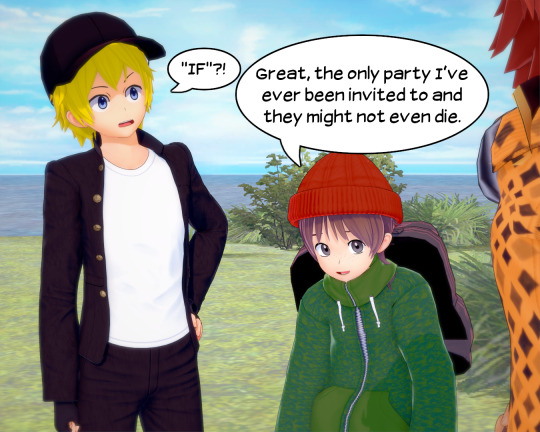
I put together an incorrect quotes comic using my Mythos region characters.
0 notes
Text

Maquette of the "Mytho" ship in the Navy Museum of Cherbourg, Normandy region of France
French vintage postcard
#vintage#photography#museum#postkarte#french#carte postale#mytho#navy#postal#region#briefkaart#maquette#france#postcard#old#normandy#the navy museum of cherbourg#photo#ansichtskarte#cherbourg#sepia#ship#postkaart#ephemera#tarjeta#historic
6 notes
·
View notes
Text
its kind of absurd how far ive made it without becoming a touhou fan
ive always been super inspired by japanese folklore, ive always been super inspired by colorful ornate multilayered costume design with frills to the max, ive always been super inspired by danmaku (the patterns and animations not the gameplay lol), touhou soundtracks have been my goto for inspiration music my entire art life, like 90% of the stories ive written are surreal whimsical mishmashes of wide ranges of paradoxical concepts with heavier undertones, i cut my worldbuilding teeth on reinterpreting scattered shinto mythos as structured spiritual heirarchy the same way tolkien did with european paganism in his early days
but out of everything thats failed to catch me for years, the thing thats finally gonna get me is the game about running an izakaya
i literally cannot resist izakaya and yatai their spirit has occupied a spot in my soul since who knows when i was first exposed to then
#mystias izakaya is also the first touhou game ive encountered that writes the characters as yokai that are just depicted as anime girls#instead of just anime girls with a few yokai traits#its like Ohhhhh i get it now. touhou is supposed to be Spirited Away but with the Moemon sprite mod#in a well written one the moe part is just on the surface and theyre actually just straight up yokai. Bad Ass#but now ive got the conundrum of do i get into touhou or keep distance cause i wanna still write yokai stuff without being influenced by it#then again i think touhou is more wide than it is deep so maybe itd be fine#i already love okami and oreshika#though i resonate far more with Totoro and Spirited Away. shinto lens and dynamics but original mythos with a unique dynamic of its own#rather than literally adapting existing legends#man watching totoro when older and realizing its hidden layer about building an original mythos for a region's forest and wind was amazing#it was like YES i loved totoro when younger and now i find all along it was about the same kinda stuff i write this is where im meant to be
10 notes
·
View notes
Note
Hi! Can you remind please how lady Midnight lost her eye? I 100% remember that you had mentioned it in one of your works, but I cant find it...
I'm not sure it was ever explicitly stated in a fic, though I'm sure I've alluded to it. I certainly don't mind sharing it.
Her High Lady Noon, is the embodiment of the sun. She is also a huge snake (usually), and she is constantly consuming her own tail, and her ouroboros shape is what makes the sun a disk.
But it wasn't always that way. She used to slither across the sky, a streak of sunlight, a golden ribbon rather than a fiery ball. One day her appetite is awakened (I've reworked this part of the story so many times never to my satisfaction. Typically it goes something along the lines of her stumbling across the Beast, maybe seeking out winter's chill, and the appetite of his fire stirring something in her own. Sometimes she just eats him, but instead of fulfilling her it just makes her hungrier)
Overcome with starvation, she turns her appetites on the world, coiling around it preparing to eat it, but as she cinches around it, the world starts to burn, and the other wardens, most of whom live on that world, object. And of the wardens, they all have reasons they can't get rid of her. The Beast will burn/melt/is currently still eaten, Tzar Spring is too close to winter, and faces a similar problem, Madame Summer isn't a corpse yet and would face very human reprecussions from trying to touch the sun, and Enoch isn't autumn yet. He's still just contented death, and thus has no stake in keeping the world going.
So the wardens petition Lady Midnight to deal with it, and they strike a deal which is a story all on its own, but she goes to unwind her love from the earth. There's a struggle, and Her High Lady Noon tosses her head back, while Lady Midnight is in the wrong place, and Her High Ladyship's crown of radiance, the rays of the sun, impales Lady Midnight through one eye.
Eventually Lady Midnight succeeds in feeding Her High Ladyship her own tail, and casting her back up into the sky, but she was never able to remove the splinter of sunlight embedded in her eye socket.
#There's also a shard of Her High Lady Noon buried in Madame Summer. It's why she's constantly radiating heat#There are shards of Her High Lady Noon's crown everywhere in the Political Saga actually.#also in my expaned mythos the band of the world that Her High Lady Noon wrapped herself around is the equator#And that's why that region is so hot#but it doesn't work naturally into the flow of the myth
4 notes
·
View notes
Text
Mythos Handwerk - Zwischen Ideal und Alltag: Bregenz bis 06.01.2025
Für ein Handwerk braucht es Hände, Material und Werkzeug. Was soll daran mythisch sein? In der Ausstellung geht es um Gefühle und Werte, die man gemeinhin mit dem Handwerk verbindet – Ehrlichkeit, Regionalität, Qualität. Und um Zuschreibungen an Produkte und die Könnerschaft ihrer Hersteller:innen, die für Regionen sogar identitätsstiftend werden können. Die Schau mit vielen Objekten und…

View On WordPress
#Alltag#angewandte Kunst#Bregenz#Handwerk#Handwerkskunst#Ideal#Identität#Kunst#Kunstgewerbemuseum Dresden#Kunsthandwerk#Museum für Angewandte Kunst Frankfurt#Mythos Handwerk#Region#Vorarlberg
0 notes
Text
Come gather 'round friends and I'll tell you a tale
Of when the red iron pits ran a-plenty
But the cardboard-filled windows and old men on the benches
Tell you now that the whole town is empty
In the north end of town my own children are grown
But I was raised on the other
In the wee hours of youth my mother took sick
And I was brought up by my brother
The iron ore poured as the years passed the door
The drag lines an' the shovels they was a-humming
'Till one day my brother failed to come home
The same as my father before him
Well, a long winter's wait from the window I watched
My friends they couldn't have been
And my schooling was cut as I quit in the spring
To marry John Thomas, a miner
Oh, the years passed again, and the giving was good
With the lunch bucket filled every season
What with three babies born, the work was cut down
To a half a day's shift with no reason
Then the shaft was soon shut, and more work was cut
And the fire in the air, it felt frozen
'Till a man come to speak, and he said in one week
That number eleven was closing
They complained in the East, they are paying too high
They say that your ore ain't worth digging
That it's much cheaper down in the South American towns
Where the miners work almost for nothing
#eivor ( soundtrack )#eivor ( mythos )#[ a north country girl making sense of things growing up in an iron rotted region and a burning world ]#Spotify
0 notes
Text

Legendaries/UBs that Sky has owned/will own:
-Latios
-Arceus (At least one of its 1000+ aspects)
-Zekrom
-Silvally
-Naganadel
-Zamazenta
-Eternatus
-Urshifu Single-Strike
-Regidrago
-Glastrier
-Galarian Zapdos
-Meltan & Melmetal
-Koraidon
-Chien-Pao
Legendaries that Sky has met/will meet:
-Latias
-Shaymin
-Lunala
-Zacian
-Regieleki
-Calyrex
-Spectrier
-Miraidon
Legendaries that Sky will never meet but has heard about:
-All other Legendaries from Gen 1 to Gen 7 (All the Legendaries he’s fought and captured before were fakes from the New World getting all screwy)
-The other 3 Treasures of Ruin
0 notes
Text

The next Arthurian knight that refutes the misconception that every character in the Arthurian mythos had to be British or otherwise exclusively Western European.
Morien was a Knight of the Round Table whose life was narrated in the 13th century Arthurian poem “Moriaen,” written in the Middle Dutch. His father was the knight Aglovale, and his mother—a princess from a “Moorish” land. Just like the common imagery of Arthur’s court doesn’t have a strictly defined era or cultural affiliation (you’ll see hundreds of paintings of 6th century British knights wearing 17th century French armour), this image represents Morien as more of a legendary figure, combining regionally accurate elements in a bit of an anachronistic fashion. One of the first cultures to be referred to as Moors by the European Christians were the Maghrebine Berber people, giving some context to which region Morien's mother could be from. Amazigh-style weapons served as a basis for his weapons, while Tuareg dyeing techniques the design of his clothing. The description of his “Moorish” clothes and his armour as black as a raven reminds me of the beautiful indigo fabrics of the Tuareg people, which can appear to shine like raven feathers. His sword is barely visible, but it is based on the flyssa, an Amazigh traditional sword. He also holds an adarga, the Amazigh leather shield, which was actually so good at—well, being a shield—that it was adopted by many cultures of Europe because of its efficacy.
5K notes
·
View notes
Text
Sri Lankan Fairies and Senegalese Goddesses: Mixing Mythology as a Mixed Creator
[Note: this archive ask was submitted before the Masterpost rules took effect in 2023. The ask has been abridged for clarity.]
@reydjarinkenobi asked:
Hi, I’m half Sri Lankan/half white Australian, second gen immigrant though my mum moved when she was a kid.
My main character for my story is a mixed demigod/fae. [...] Her bio mum is essentially a Scottish/Sri Lankan fairy and her other bio mum (goddess) is a goddess of my own creation, Nettamaar, who’s name is derived from [...] Wolof words [...]. The community of mages that she presided over is from the South Eastern region of Senegal [...] In the beginning years of European imperialism, the goddess basically protected them through magic and by blessing a set of triplets effectively cutting them off from the outside world for a few centuries [...]
I was unable to find a goddess that fit the story I wanted to tell [...] and also couldn’t find much information on the internet for local gods, which is why I have created my own. I know that the gods in Hinduism do sort of fit into [the story] but my Sri Lankan side is Christian and I don’t feel comfortable representing the Hindu gods in the way that I will be this goddess [...]. I wanted to know if any aspect of the community’s history is problematic as well as if I should continue looking further to try and find an African deity that matched my narrative needs?
I was also worried that having a mixed main character who’s specifically half black would present problems as I can’t truly understand the black experience. I plan on getting mixed and black sensitivity readers once I finish my drafts [...] I do take jabs at white supremacy and imperialism and I I am planning to reflect my feelings of growing up not immersed in your own culture and feeling overwhelmed with what you don’t know when you get older [...].
I’m sorry for the long ask but I don’t really have anyone to talk to about writing and I’m quite worried about my story coming across as insensitive or problematic because of cultural history that I am not educated enough in.
Reconciliation Requires Research
First off: how close is this world’s history to our own, omitting the magic? If you’re aiming for it to be essentially parallel, I would keep in mind that Senegal was affected by the spread of Islam before the Europeans arrived, and most people there are Muslim, albeit with Wolof and other influences.
About your Scottish/Sri Lankan fairy character: I’ll point you to this previous post on Magical humanoid worldbuilding, Desi fairies as well as this previous post on Characterization for South Asian-coded characters for some of our commentary on South Asian ‘fae’. Since she is also Scottish, the concept can tie back to the Celtic ideas of the fae.
However, reconciliation of both sides of her background can be tricky. Do you plan on including specific Sri Lankan mythos into her heritage? I would tread carefully with it, if you plan to do so. Not every polytheistic culture will have similar analogues that you can pull from.
To put it plainly, if you’re worried about not knowing enough of the cultural histories, seek out people who have those backgrounds and talk to them about it. Do your research thoroughly: find resources that come from those cultures and read carefully about the mythos that you plan to incorporate. Look for specificity when you reach out to sensitivity readers and try to find sources that go beyond a surface-level analysis of the cultures you’re looking to portray.
~ Abhaya
I see you are drawing on Gaelic lore for your storytelling. Abhaya has given you good links to discussions we’ve had at WWC and the potential blindspots in assuming, relative to monotheistic religions like Christianity, that all polytheistic and pluralistic lore is similar to Gaelic folklore. Fae are one kind of folklore. There are many others. Consider:
Is it compatible? Are Fae compatible with the Senegalese folklore you are utilizing?
Is it specific? What ethnic/religious groups in Senegal are you drawing from?
Is it suitable? Are there more appropriate cultures for the type of lore you wish to create?
Remember, Senegalese is a national designation, not an ethnic one, and certainly not a designation that will inform you with respect to religious traditions. But more importantly:
...Research Requires Reconciliation
My question is why choose Senegal when your own heritage offers so much room for exploration? This isn’t to say I believe a half Sri-Lankan person shouldn’t utilize Senegalese folklore in their coding or vice-versa, but, to put it bluntly, you don’t seem very comfortable with your heritage. Religions can change, but not everything cultural changes when this happens. I think your relationship with your mother’s side’s culture offers valuable insight to how to tackle the above, and I’ll explain why.
I myself am biracial and bicultural, and I had to know a lot about my own background before I was confident using other cultures in my writing. I had to understand my own identity—what elements from my background I wished to prioritize and what I wished to jettison. Only then was I able to think about how my work would resonate with a person from the relevant background, what to be mindful of, and where my blindspots would interfere.
I echo Abhaya’s recommendation for much, much more research, but also include my own personal recommendation for greater self-exploration. I strongly believe the better one knows oneself, the better they can create. It is presumptuous for me to assume, but your ask’s phrasing, the outlined plot and its themes all convey a lack of confidence in your mixed identity that may interfere with confidence when researching and world-building. I’m not saying give up on this story, but if anxiety on respectful representation is a large barrier for you at the moment, this story may be a good candidate for a personal project to keep to yourself until you feel more ready.
(See similar asker concerns here: Running Commentary: What is “ok to do” in Mixed-Culture Supernatural Fiction, here: Representing Biracial Black South American Experiences and here: Am I fetishizing my Japanese character?)
- Marika.
Start More Freely with Easy Mode
Question: Why not make a complete high-fantasy universe, with no need of establishing clear real-world parallels in the text? It gives you plenty of leg room to incorporate pluralistic, multicultural mythos + folklore into the same story without excessive sweating about historically accurate worldbuilding.
It's not a *foolproof* method; even subtly coded multicultural fantasy societies like Avatar or the Grishaverse exhibit certain harmful tropes. I also don't know if you are aiming for low vs high fantasy, or the degree of your reliance on real world culture / religion / identity cues.
But don't you think it's far easier for this fantasy project to not have the additional burden of historical accuracy in the worldbuilding? Not only because I agree with Mod Marika that perhaps you seem hesitant about the identity aspect, but because your WIP idea can include themes of othering and cultural belonging (and yes, even jabs at supremacist institutions) in an original fantasy universe too. I don't think I would mind if I saw a couple of cultural markers of a Mughal Era India-inspired society without getting a full rundown of their agricultural practices, social conventions and tax systems, lol.
Mod Abhaya has provided a few good resources about what *not* to do when drawing heavily from cultural coding. With that at hand, I don't think your project should be a problem if you simply make it an alternate universe like Etheria (She-Ra and the Princesses of Power), Inys (The Priory of the Orange Tree) or Earthsea (the Earthsea series, Ursula K. Le Guin). Mind you, we can trace the analogues to each universe, but there is a lot of freedom to maneuver as you wish when incorporating identities in original fantasy. And of course, multiple sensitivity readers are a must! Wishing you the best for the project.
- Mod Mimi
#asks#multiracial#multicultural#south asian#sri lankan#senegalese#west african#identity#representation#worldbuilding#fantasy#mythology#folklore#fairies#deities#adoption#identity issues#mixed experiences#coding
535 notes
·
View notes
Text
Wolf Moon - January 24-25, 2024

Shake off the cold and sing to the sky, witches - it's time for the Wolf Moon!
Wolf Moon
The Wolf Moon is the name given to the full moon which occurs in the month of January. The name is said to be derived from the sound of wolves howling with hunger while prey is scarce in the midst of winter. Given that we now know that wolves howl mostly for communication, my personal opinion is that people huddled in their homes during a very dark and dangerous time of year probably noticed these sounds a lot more readily with little else to occupy their time as they waited out the winter, and thus were set to worrying about ravenous beasts invading their villages and farmsteads. (It's worth noting that wolves preying on livestock was a very real concern for most people outside major cities for many centuries, so this isn't entirely unfounded.)
The name also calls to mind the howling of the wind during winter storms, or whistling around the eaves during the long cold nights. And for those of us who might not have been careful with our spending over the holidays, I might cite a tongue-in-cheek reference to the wolves being at the door when those credit card bills come due.
[For those not familiar with the phrase, to have "a wolf at the door" is a saying that refers to some imminent hardship or disaster. In modern parlance, this is usually applied to poor finances or looming bankruptcy.]
This month, the moon peaks at 12:54pm EST on January 25th, so the moon will likely appear to be full on the nights of the 24th and 25th, depending on where you are in the world.
Some North American indigenous names for the month of January and its' moon are Cold Moon (Cree), Center Moon (Assiniboine), Severe Moon (Dakota), Ice Moon (Catawba), and Spirit Moon (Ojibwe). Other names include Mantis Moon (South African origins), Quiet Moon (Celtic), and Moon After Yule (Anglo-Saxon).
What Does It Mean For Witches?
As a new year dawns, it's time for rest and reflection before we set out on the next phase of our journey. While the cold weather lingers, take some time to sit by the fire, literally or metaphorically, and take stock of where you stand, what resources are available, and what you plan to do with them.
Check in with your near-and-dear following the mad rush of the holiday season as well. Make sure that friends, family, and community members around you are doing all right. Offer support and kindness where you can, but don't overextend yourself. It's your time to recuperate too, and it is good and healthy to set boundaries which allow time and space for yourself.
What Witchy Things Can We Do?
Winter is a prime time for storytelling. Back in the days before internet or television or radio, people would often read to each other or tell tales to pass the time. Consider re-reading a favorite book that inspires you or exploring some region of folklore or mythology you've been meaning to look into. If you have children who are of an age to enjoy stories, read them some of your favorites or introduce them to something new. Share stories and discussions with your witchy circle too!
While you're at it, take a moment to examine the role that folklore and stories play in your practice. If you subscribe to a particular mythos, be it through deities or just general belief, consider which parts of it resonate the most with you and why.
Consider also the lessons of the winter season - the necessity of rest between periods of growth and activity, and the role of death, cold, and darkness in the natural cycles of life. What do these things mean to you and your practice? Are they a source of fear or fascination? Do you come alive in the winter or bundle up and wait for spring? How can you best remind yourself to pause for breath as the year goes on?
And of course, the beginning of a new year is an excellent time for goal-setting and divination. You're making resolutions for your mundane life, so make a few for your craft while you're at it, and pull out your cards or runes or pendulum for a New Year forecast on how things might go.
Happy Wolf Moon, witches! 🐺🌕
SOURCES & FURTHER READING:
Bree's Lunar Calendar Series
Bree's Secular Celebrations Series
Wolf Moon: Full Moon in January, The Old Farmer's Almanac.
Full Moon January 2024: Discover the Wolf's Thrilling Spiritual Meaning, The Peculiar Brunette.
Moon Info - Full Moon Dates for 2024
Calendar-12 - 2024 Moon Phases
Image Source: What Is A Wolf Moon?, The Fact Site.
#witchcraft#witchblr#witch community#pagan#moon magic#lunar magic#full moon#wolf moon#lunar calendar
232 notes
·
View notes
Text
I have a lot of complicated feelings when it comes to what Neflix has done with the Witcher, but my probably least favourite is the line of argumentation that originated during shitstorms related to the first and second season that I was unlucky to witness.
It boils down to "Netflix's reinterpretation and vision is valid, because the Witcher books are not written to be slavic. The overwhelming Slavic aestetic is CDPR's interpretation, and the setting in the original books is universally European, as there are references to Arthurian mythos and celtic languages"
And I'm not sure where this argument originated and whether it's parroting Sapkowski's own words or a common stance of people who haven't considered the underlying themes of the books series.
Because while it's true that there are a lot of western european influences in the Witcher, it's still Central/Eastern European to the bone, and at its core, the lack of understanding of this topic is what makes the Netflix series inauthentic in my eyes.
The slavicness of the Witcher goes deeper than the aestetics, mannerisms, vodka and sour cucumbers. Deeper than Zoltan wrapping his sword with leopard pelt, like he was a hussar. Deeper than the Redanian queen Hedvig and her white eagle on the red field.
What Witcher is actually about? It's a story about destiny, sure. It's a sword-and-sorcery style, antiheroic deconstruction of a fairy tale, too, and it's a weird mix of many culture's influences.
But it's also a story about mundane evil and mundane good. If You think about most dark, gritty problems the world of Witcher faces, it's xenophobia and discrimination, insularism and superstition. Deep-seated fear of the unknown, the powerlessness of common people in the face of danger, war, poverty and hunger. It's what makes people spit over their left shoulder when they see a witcher, it's what makes them distrust their neighbor, clinging to anything they deem safe and known. It's their misfortune and pent-up anger that make them seek scapegoats and be mindlessly, mundanely cruel to the ones weaker than themselves.
There are of course evil wizards, complicated conspiracies and crowned heads, yes. But much of the destruction and depravity is rooted in everyday mundane cycle of violence and misery. The worst monsters in the series are not those killed with a silver sword, but with steel.
it's hard to explain but it's the same sort of motiveless, mundane evil that still persist in our poorer regions, born out of generations-long poverty and misery. The behaviour of peasants in Witcher, and the distrust towards authority including kings and monarchs didn't come from nowhere.
On the other hand, among those same, desperately poor people, there is always someone who will share their meal with a traveller, who will risk their safety pulling a wounded stranger off the road into safety. Inconditional kindness among inconditional hate. Most of Geralt's friends try to be decent people in the horrible world. This sort of contrasting mentalities in the recently war-ridden world is intimately familiar to Eastern and Cetral Europe.
But it doesn't end here. Nilfgaard is also a uniquely Central/Eastern European threat. It's a combination of the Third Reich in its aestetics and its sense of superiority and the Stalinist USSR with its personality cult, vast territory and huge army, and as such it's instantly recognisable by anybody whose country was unlucky enough to be caught in-between those two forces. Nilfgaard implements total war and looks upon the northerners with contempt, conscripts the conquered people forcibly, denying them the right of their own identity. It may seem familiar and relevant to many opressed people, but it's in its essence the processing of the trauma of the WW2 and subsequent occupation.
My favourite case are the nonhumans, because their treatment is in a sense a reminder of our worst traits and the worst sins in our history - the regional antisemitism and/or xenophobia, violence, local pogroms. But at the very same time, the dilemma of Scoia'Tael, their impossible choice between maintaining their identity, a small semblance of freedom and their survival, them hiding in the forests, even the fact that they are generally deemed bandits, it all touches the very traumatic parts of specifically Polish history, such as January Uprising, Warsaw Uprising, Ghetto Uprising, the underground resistance in WW2 and the subsequent complicated problem of the Cursed Soldiers all at once. They are the 'other' to the general population, but their underlying struggle is also intimately known to us.
The slavic monsters are an aestetic choice, yes, but I think they are also a reflection of our local, private sins. These are our own, insular boogeymen, fears made flesh. They reproduce due to horrors of the war or they are an unprovoked misfortune that descends from nowhere and whose appearance amplifies the local injustices.
I'm not talking about many, many tiny references that exist in the books, these are just the most blatant examples that come to mind. Anyway, the thing is, whether Sapkowski has intended it or not, Witcher is slavic and it's Polish because it contains social commentary. Many aspects of its worldbuilding reflect our traumas and our national sins. It's not exclusively Polish in its influences and philosophical motifs of course, but it's obvious it doesn't exist in a vacuum.
And it seems to me that the inherently Eastern European aspects of Witcher are what was immediately rewritten in the series. It seems to me that the subtler underlying conflicts were reshaped to be centered around servitude, class and gender disparity, and Nilfgaard is more of a fanatic terrorist state than an imposing, totalitarian empire. A lot of complexity seems to be abandoned in lieu of usual high-fantasy wordbuilding. It's especially weird to me because it was completely unnecessary. The Witcher books didn't need to be adjusted to speak about relevant problems - they already did it!
The problem of acceptance and discrimination is a very prevalent theme throughout the story! They are many strong female characters too, and they are well written. Honestly I don't know if I should find it insulting towards their viewers that they thought it won't be understood as it was and has to be somehow reshaped to fit the american perpective, because the current problems are very much discussed in there and Sapkowski is not subtle in showing that genocide and discrimination is evil. Heck, anyone who has read the ending knows how tragic it makes the whole story.
It also seems quite disrespectful, because they've basically taken a well-established piece of our domestic literature and popular culture and decided that the social commentary in it is not relevant. It is as if all it referenced was just not important enough and they decided to use it as an opportunity to talk about the problems they consider important.
And don't get me wrong, I'm not forcing anyone to write about Central European problems and traumas, I'm just confused that they've taken the piece of art already containing such a perspective on the popular and relevant problem and they just... disregarded it, because it wasn't their exact perspective on said problem.
And I think this homogenisation, maybe even from a certain point of view you could say it's worldview sanitisation is a problem, because it's really ironic, isn't it? To talk about inclusivity in a story which among other problems is about being different, and in the same time to get rid of motifs, themes and references because they are foreign? Because if something presents a different perspective it suddenly is less desirable?
There was a lot of talking about the showrunners travelling to Poland to understand the Witcher's slavic spirit and how to convey it. I don't think they really meant it beyond the most superficial, paper-thin facade.
#The witcher#Sorry if its convoluted I just got reminded of something and it made me a little angry#and as I had this conversation a lot of times I've decided to put it into written text#sorry about being bitter#but these are some of my favourite books and I'm still upset when I get reminded how badly they were treated in the recent adaptation#I'm not saying you should never change anything#But it's good to have enough background to understand why some things are the way they are in the original#and to understand what the source material is about#we don't talk about particular character's looks or something (altough I feel they could care more about it too)#but central themes tropes and motifs#long post#it may seem like I'm talking from a high horse here#people are welcome to interpret literature however they want#Nobody has a monopol on themes#I just think that in this particular case the cultural context influences the worldbuilding#and if changed it doesn't have the same impact anymore#meta
154 notes
·
View notes
Text
the sea is a terrible place (or: here's some scary natural phenomena found in the sea of Siren)
The false reflection, mostly encountered by deep-diving phocids. This phenomenon occurs when ultra dense high saline water gathers in underwater brine pools on the sea floor. It appears reflective, like a mirror. Down in the deep, the only way you can see at all is to take some form of luminescence with you, which obscures the pool and shows you nothing but another phocid below, holding a light source. It's common for pelagic people to be unfamiliar with their own facial markings and reflection. They mistake the reflection as another phocid, or a ghostly apparition, and reach out. But the salinity of the brine pool is such that even touching it can scald the skin, especially as all mammals on siren are adapted to low salt conditions and require far far less salt than unaltered humans.
The abyss, of course. Most of the sea of Siren is not as deep on average as the sea on Earth. But there are cracks and trenches in the sea floor that go down, and down, and down... they are poorly explored (though the first settlers did send drones down) and sites of myth and legend for swimmers. The abyss is not usually dangerous, since it's easy to just not go down there, but sometimes the cracks seem to inhale and exhale - natural flows of groundwater, or attempts to fill a vacuum caused by a different crack releasing gas. So swimming over certain cracks might result in you being dragged down unexpectedly into the anoxic zone near the sea floor in the region... or it might result in you being unexpectedly shot up. These events are incredibly rare and usually passed off as tall tales, some selkie who claims to have flown due to being propelled into the sky
The snowstorm... an event that occurs when the sediment is agitated enough to completely white out the water. If the particles are the right size, echolocation clicks bounce back immediately, making sight and echo useless. Phocids and selkies trapped in the snowstorm could lose situational awareness and forget which way is up very easily, and the instant bounce-back of echo clicks is deeply unpleasant, giving the illusion of being 1 inch from swimming straight into a solid wall.
Shriekers. This is an issue where ice caps, glaciers etc meet the water. The ice cracks and breaks, and to sensitive phocid and selkie ears it's an unbearable shriek that can render them disoriented and deaf at long range, and break eardrums at close range. Around the ice wall, there's an almost constant background noise of screaming.
The false sky. A phenomenon that occurs when a swimmer loses situational awareness, and ends up diving deeper and deeper thinking that they're about to come up for air. The reduced gravity of siren means that it's more difficult under the water to feel gravity, resulting in a more weightless sensation than on Earth. Occasionally, a natural biolumescence in deep water may produce an illusion of the sky viewed through the turbid water, making the disoriented swimmers even more certain that they are travelling up, when really they are diving. In Spiral mythos this is treated as a specific type of mania.
The wanderer.. it looks like a phocid swimming in the distance. You hail them, click at them, wave your lantern, but they don't respond. If you get closer, they'll flee. This is a really common story among nearly all pelagic people worldwide, and what they are seeing are the vanishingly rare aquatic zeta, those who did not adapt to becoming terrestrial and became extremely solitary, so they were not able to regain language due to not having complex cultures and societies anymore. They resemble smaller, hairy phocids and are considered a type of (for lack of a better word?) fairy or trickster spirit in Spiral culture, a false friend leading you astray.
The flesh cloud. This is a mass of deceased scalefish, the hagfish-like animals which make up many of the fish shoals on Siren. If they enter an anoxic zone unexpectedly (if chased, pushed by currents, or just unlucky) they can die in large numbers, forming a tangled, decaying mass that drifts through the seas. These are heralds of rot and disease and the water around them is filthy and unclean, an infection risk for any swimmer with an open cut. Sometimes large nets are set up to catch and redirect them.
Sharp sand. Some substrate is made of silica and appears glittery, like fairy dust. When water mixes, these can form plumes which are hundreds of feet tall. They're not dangerous in and of themselves, but you had better make sure you close your eyes around it, no matter how pretty the dancing glitter might be. A common cause of corneal ulceration and abrasion.
Cherta's Tide. This is a big one. Tides are slow and rare most of the time, mixing the water and enabling life to flourish. But every so often, there are two different tides that come round, which can be predicted based on which moon is most prominent in the sky for the duration. Ishmael's Tide is a high water apocalyptic event, but there are many monitoring stations and contingencies to avoid it. Cherta's Tide (similar to a neap tide) is far more unpredictable and occurs irregularly, as the moon Cherta is smaller, darker, and harder to see. This tide is a low-water event. Vast stretches of the sea floor are laid bare and the underwater ridges suddenly become towering cliffs and barriers for people who can't fly. This can last for weeks at a time, and without the water of course most animal populations who can't hide in substrate take a huge hit. It can happen fast enough to strand a swimmer at the top of a ridge, nothing but air below all the way to what was once the sea floor, and they might be stranded, unreachable, and without food or water for a fatal period of time.
#i made these as a challenge to myself because i didn't want to rely on 'it's scary because monsters are there'#the sea ITSELF is scary#setting: siren#speculative biology
129 notes
·
View notes
Text
They're really pulling some niche figures for these new Personas, huh?
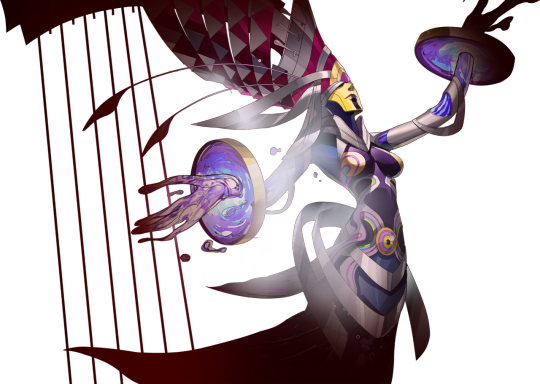
Prosymna is one of three naiad daughters of the Greek river god Asterion. Along with her sisters (Acraea and Euboea), she served as a wet-nurse for Hera. The name Prosymna means "celebrate in song," which explains her harp-like design.
(Prosymna is also a genus of snake!)

Erytheia is one of the three (or four, or seven) Hesperides, nymphs who presided over evening and sunsets. The name Erytheia means "the red one." There doesn't seem to be much mythos surrounding Erytheia specifically, but her name was assigned to a small island northwest of Gilbraltar. (Nowadays it's part of Spain! The city of Cadíz can be found there.)
Preceded by Leucothea, Erytheia is one of the two (possibly 3?) P5X Persona to be rendered as a masculine entity despite being based off a distinctly feminine mythological figure. Not sure why they're doing that, but hey, the designs are great!

Syke is a bit of an oddball. While it would be easy to presume it's meant to represent Psyche, the Greek goddess of the soul…Psyche has already appeared as Metis' Persona back in P3 FES, so it's possible this one is a different entity. However, something worth noting: like the other Greek myth Persona in this post, Psyche came in a set of three, having been the youngest of three sisters.
Of what I've been able to dig up, Syke (or Syca) was also the name of a town in ancient Cilicia, a region in southern Anatolia. Another name for Syke was Setos, possibly based off the primordial sea goddess Ceto. Ceto is considered one of the oldest-known deities in Greek myth, and was mother to a myriad of monsters, such as the Graiae and Gorgon sisters.

Meng Po is the Chinese goddess of forgetfulness, tasked with ensuring that souls headed for reincarnation are reborn with no memories. To accomplish this, she serves a memory-wiping soup to souls crossing the Naihe Bridge out of Diyu, a subterranean maze that serves as an equivalent to hell in Chinese mythology.
This lore explains both the bowl and lantern in this Persona's design. The bowl represents the soup, obviously enough, while the lantern can be interpreted as symbolic of "guiding the dead."
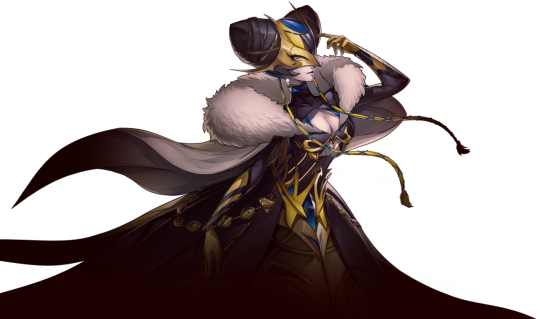
Cleodora was one of the three Thriae, prophetic nymphs who lived in the Corycian Cave of Mt. Parnassus. Though the Thriae are often considered to be the "bee-maidens" (women bearing human heads/torsos and bee wings/lower bodies) described in the Homeric Hymn to Hermes, it's possible they're different trios; the Thriae predicted the future through throwing stones (pessomancy/mantic pebbles), while the bee-maidens predicted the future through casting lots (cleromancy).
The only info I can find on Cleodora as separate from the Thriae states that she was the mother of Parnassos, who invented a way to predict the future based on birds (ornithomancy).
#persona 5 x#p5x#persona 5 the phantom x#prosymna#erytheia#syke#meng po#cleodora#Kidd speaking#not aesthetic
179 notes
·
View notes
Text
UNBLENDING CELTIC POLYTHEISTIC PRACTICES
Celtic Umbrella
This lesson is largely focusing on the insular Celtic nations & Brittany (Ireland/Eire, Scotland/Alba, Wales/Cymru, Cornwall/Kernow, Isle of Man/Mannin, & Brittany/Breizh) - traditionally regarded as 6 out of the 7 Celtic nations. Galicia/Galizia is the 7th, but because of a mix of the below + my own lack of knowledge, I won't be covering them.
The vast swath of Continental Celtic cultures are a different but equally complex topic thanks to extinction, revival, varying archaeological artefacts and the work of modern practioners to piece unknown parts back together.
This will serve as a quick 'n' dirty guide to the insular Celtic nations, Celtic as a label, blood percentages and ancestry, the whats and whys of "Celtic soup", and how to unblend practice.
The insular Celtic groups are split into two language groups: Brythonic languages and Gaelic languages.
Brythonic languages are Cymraeg/Welsh, Kernewek/Cornish, & Breton
Gaelic languages are Gàidhlig/Scottish, Gaeilge/Irish, & Gaelg/Manx.
The language split leads to certain folkloric and religious figures & elements being more common within the language group than without. All of these nations had historic cultural exchange and trade routes via the Celtic sea (and beyond). Despite this, it is still important to respect each as a home to distinct mythologies.
Pros/Cons of a broad Celtic umbrella
Pros
- Used within celtic nations to build solidarity
- Relates to a set of cultures that have historic cultural exchange & broad shared experiences
- A historic group category
- Celtic nations’ culture is often protected under broad legislation that explicitly highlights its ‘Celtic-ness’.
Cons
- Can be used reductively (in academia & layman uses)
- Often gives in to the dual threat of romanticisation/fetishisation & erasure
- Conflates a lot of disparate practices under one banner
- Can lead to centring ‘celtic american’ experiences.
- Celtic as a broad ancestral category (along with associated symbols) has also been co-opted by white supremacist organisations.
In this I’m using ‘Celtic’ as a broad umbrella for the multiple pantheons! This isn’t ideal for specifics, but it is the fastest way to refer to the various pantheons of deities that’ll be referenced within this Q&A (& something that I use as a self identifier alongside Cornish).
What about blood % or ancestry?
A blood percentage or claimed Celtic ancestry is NOT a requirement to be a follower of any of the Celtic pantheons. The assumption that it does or is needed to disclose can feed easily into white supremacist narratives and rhetoric, along side the insidious implications that a white person in the USA with (perceived or real) Celtic ancestry is 'more celtic' than a person of colour living in a Celtic region (along with other romanticised notions of homogenously white cultures).
Along side this, a blood percentage or distant ancestry does not impart the culture and values of the Celtic region or it's recorded pagan practices by itself. Folk traditions are often passed down within families, but blood percentage is not a primary factor within this.
Connecting with ancestry is fine, good, and can be a fulfilling experience. It stops being beneficial when it leads to speaking over people with lived experiences & centres the USA-based published and authors - which can lead to blending/souping for reasons further on.
What is 'soup'?
Celtic soup is a semi-playful term coined by several polytheists (primarily aigeannagusacair on wordpress) to describe the phenomenon of conflating & combining all the separate pantheons and practices from the (mainly) insular Celtic nations into one singular practice - removing a lot of the regionalised folklore, associated mythos, & varying nuances of the nations that make up the soup.
Why does it happen?
The quick version of this is book trends and publishing meeting romanticisation and exotification of Celtic cultures (especially when mixed with pre-lapsarian views of the Nations). It's miles easier to sell a very generally titled book with a lot of Ireland and a little of everywhere else than it is to write, source and publish a separate book on each.
This is where centering American publishers and authors becomes an issue - the popular trend of USA-based pagan publications to conflate all celtic nations makes it hard to find information on, for example, Mannin practices because of the USA’s tendency to dominate media. Think of Llewellyn’s “Celtic Wisdom” series of books.
It has also been furthered by 'quick research guides'/TL;DR style posts based on the above (which have gained particular momentum on tumblr).
The things that have hindered the process in unblending/"de souping" is the difficulty in preserving independently published pamphlets/books from various nations (often more regionalised and immediately local than large, sweeping books generalising multiple practices) along with the difficulty of accessing historic resources via academic gatekeeping.
All of this has lead to a lack of awareness of the fact there is no, one, singular Celtic religion, practice or pantheon.
Why should I de-soup or unblend my practice?
Respecting the deities
It is, by and large, considered the bare minimum to understand and research a deity's origin and roots. The conflation of all insular Celtic deities under one singular unified pantheon can divorce them from their original cultures and contexts - the direct opposite to understanding and researching.
Folklore and myth surrounding various Celtic deities can be highly regionalised both in grounded reality and geomythically - these aren't interchangeable locations and are often highly symbolic within each nation.
Brú na Bóinne, an ancient burial mound in Ireland, as an entrance to the otherworld of the Tuatha Dé Danann.
Carn Kenidjack & the Gump as a central site of Cornish folk entities feasts and parties, including Christianised elements of Bucca’s mythology.
The Mabinogion includes specific locations in Wales as well as broad Kingdoms - it’s implied that Annwn is somewhere within the historic kingdom of Dyfed, & two otherworldly feasts take place in Harlech & Ynys Gwales.
Conflating all celtic pantheons under one banner often leads to the prioritisation of the Irish pantheon, meaning all of the less ‘popular’ or recorded deities are sidelined and often left unresearched (which can lead to sources & resources falling into obscurity and becoming difficult to access).
Respecting the deities
Deities, spirits, entities, myth & folklore are often culturally significant both historically and to modern day people (just average folks along with practitoners/pagans/polytheists and organisations) located in the various Nations
A primary example is the initiatory Bardic orders of Wales and Cornwall.
Desouping/Unblending makes folklorist's lives easier as well as casual research less difficult to parse. The general books are a helpful jumping off point but when they constitute the bulk of writing on various Celtic polytheisms, they become a hinderance and a harm in the research process.
A lot of mythology outside of deities & polytheisms is also a victim of ‘souping' and is equally as culturally significant - Arthurian mythology is a feature of both Welsh and Cornish culture but is often applied liberally as an English mythology & and English figure.
Celtic nations being blended into one homogenous group is an easy way to erase cultural differences and remove agency from the people living in celtic nations. Cornwall is already considered by a large majority of people to be just an English county, and many areas of Wales are being renamed in English for the ease of English tourists.
How can I de-soup?
Chase down your sources' sources, and look for even more sources
Check your sources critically. Do they conflate all pantheons as one? Do they apply a collective label (the celts/celts/celt/celtic people) to modern day Celtic nations? How far back in history do they claim to reach?
Research the author, are they dubious in more ways than one? Have they written blog articles you can access to understand more of their viewpoints? Where are they located?
Find the people the author cites within their work - it can be time consuming but incredibly rewarding and can also give a good hint at the author's biases and research depth. You may even find useful further reading!
Find primary sources (or as close too), or translations of the originating folklore, e.g The Mabinogion. Going to the source of a pantheon’s mythos and folklore can be helpful in discerning where soup begins in more recent books as well as gaining insight into deities' actions and relationships.
Ask lots of questions
Question every source! Question every person telling you things that don't define what pantheon or region they’re talking about! Write all your questions down and search for answers! Talk to other polytheists that follow specific Celtic pantheons, find where your practices naturally overlap and where they have been forced into one practice by authors!
Be honest with yourself
There’s no foul in spreading your worship over several pantheons that fall under the celtic umbrella! A lot of polytheists worship multiple pantheons! But be aware of the potential for soup, and make sure you’re not exclusively reading and working from/with sources that conflate all practices as one.
If you approach any Celtic polytheistic path with the attitude of blood percentage or 'ancestral right', stop and think critically about why you want to follow a Celtic polytheistic path. Is it because it's the most obviously 'open' path to follow? Is it a desire to experience what other folks experience? Being critical, turning inward, and really looking at yourself is important.
Originally posted in the Raven's Keep discord server
#celtic polytheism#celtic paganism#celtic soup#celtic#celtic reconstructionism#celtic revivalism#celtic polytheist#celtic pagan#celtic religion
435 notes
·
View notes
Text
okay i just talked to every NPC in veilstone because it's been a long time and man sinnoh's NPCs are peak, at least out of the 2D games i feel like they provide the most humor and the most random lore tidbits and stuff. i love this region. i'm going to talk about it
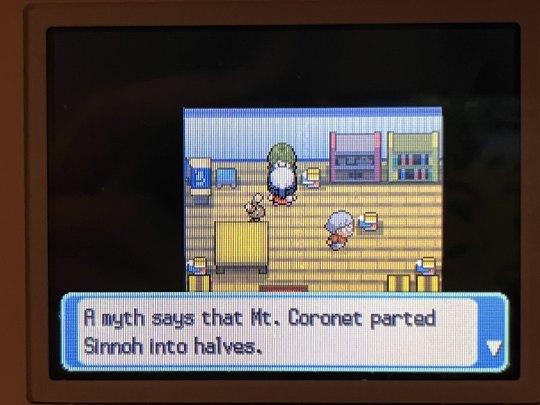

first off sinnoh is full of little things like this. random dialogue/flavor text that ties back to the mythos of the region. i love how widespread the sinnoh myths are

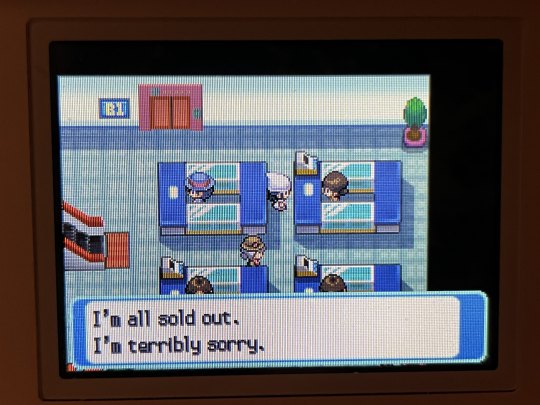
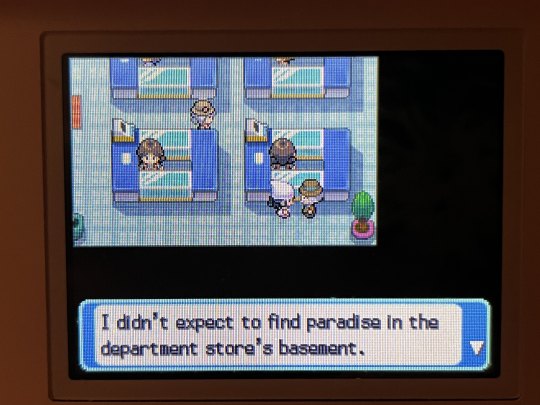

i'm also obsessed with when there's two NPCs that link together like this. you talk to one and you move on and then you talk to another and you're like oh! lmao. by the way the rage candy bars being here is cool because sinnoh is canonically connected to johto through the sinjoh ruins and the rage candy bars are from johto, which means they're imported and sold here. in general i'm obsessed with the locations in pokemon that have special treats associated with them, like the pewter crunchies of pewter city in kanto, or the lava cookies from lavaridge in hoenn. iconic


btw don't worry lady literally everyone sucks at making poffins. unless you have four players it's pretty much impossible to make poffins that are better than the storebought ones. good luck getting four people with rare berries who are good at the minigame to play with you, ESPECIALLY in 2023 jesus christ. the basement poffins are OPTIMAL
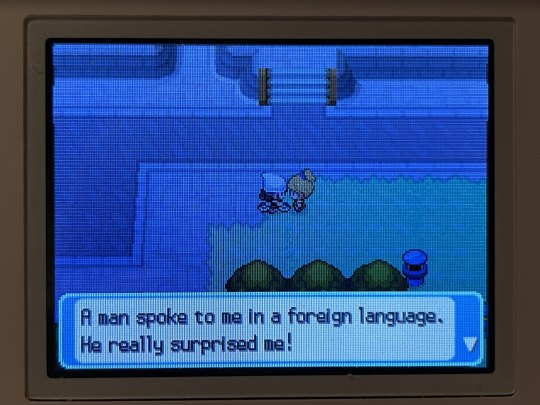
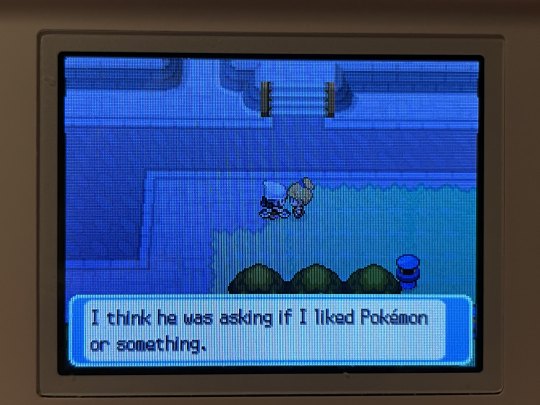
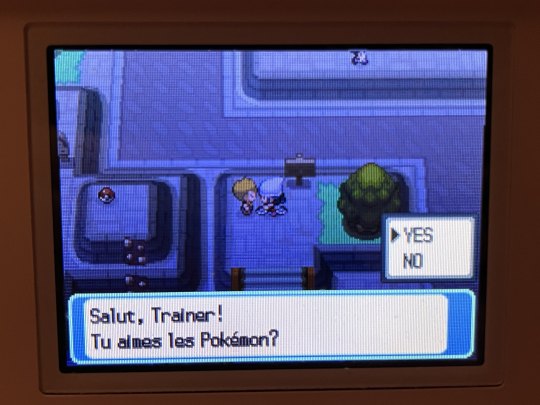
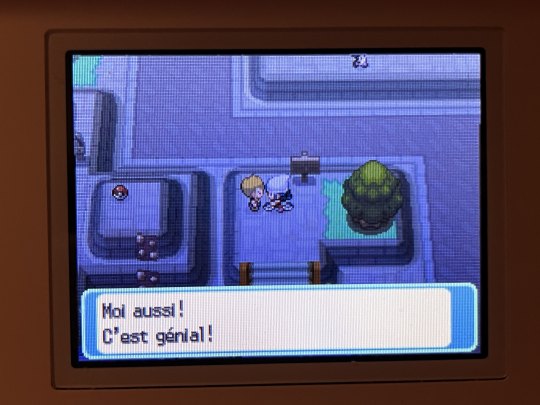
anyway in speaking of linking NPCs, these two - i wonder if the dialogue in the french version of this game is turned into english? they did that for lt. surge's french pikachu trade, the french versions of HGSS make the pikachu english instead lol. but anyway as usual it's very fascinating to me how much pokemon loves to drop foreign language in its titles, and fittingly i know a lot of people with english as their second language got interested in learning english from a young age due to wanting to play pokemon. how many kids do you think got interested in french because of dialogue like this. the girl even implies what the meaning of his words is


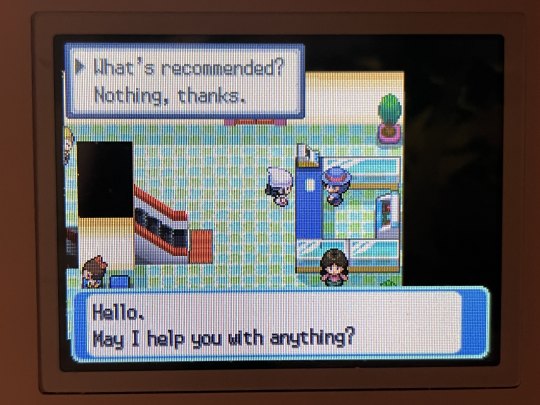
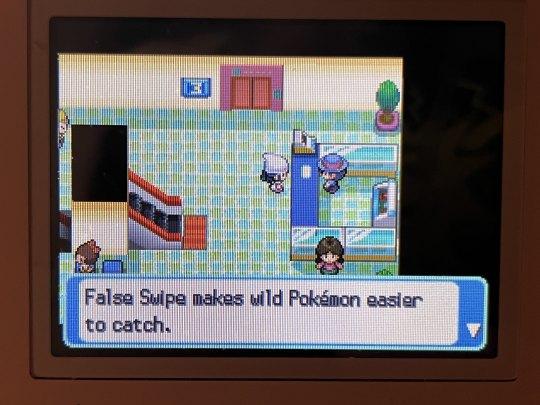
veilstone isn't short on game hints either, useless to me now as an adult longterm pokemon player who knows all this stuff already but still really cool to see. if sinnoh is your first time playing pokemon, those hints on trade evos and stuff are always appreciated.
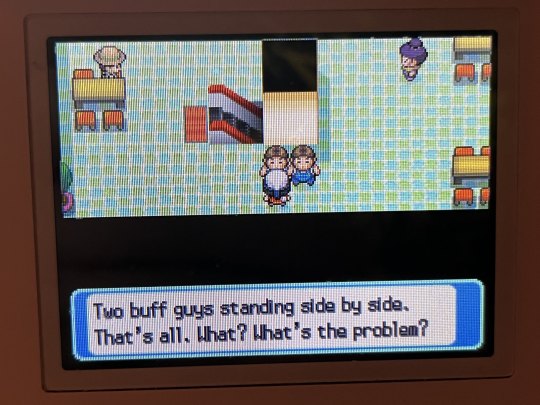
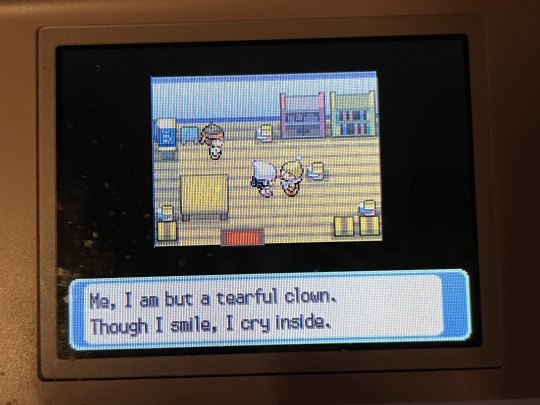
of course, funny dialogue too that got a wheeze out of my nose, not uncommon for pokemon NPC dialogue SDKFSFDK some of this shit takes me so offguard it's like extra funny
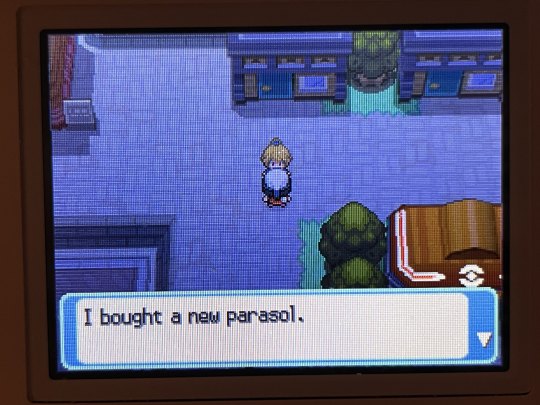
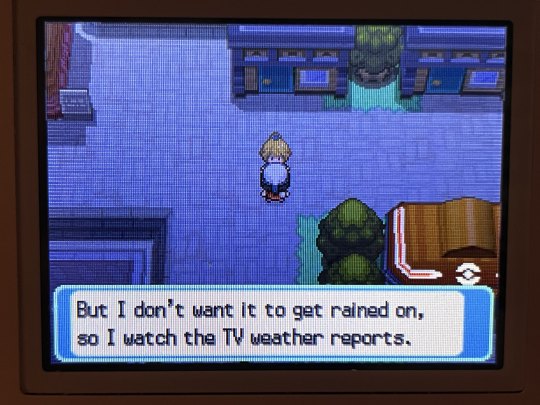
like GIRL ISN'T THAT WHAT A PARASOL IS FOR????
edit: my DUMB ASS (lighthearted) has been reminded that parasols are for the sun and are NOT an umbrella equivalent. okay she makes more sense now LOOL
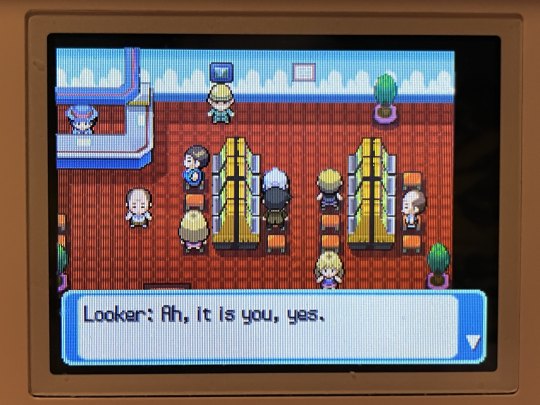
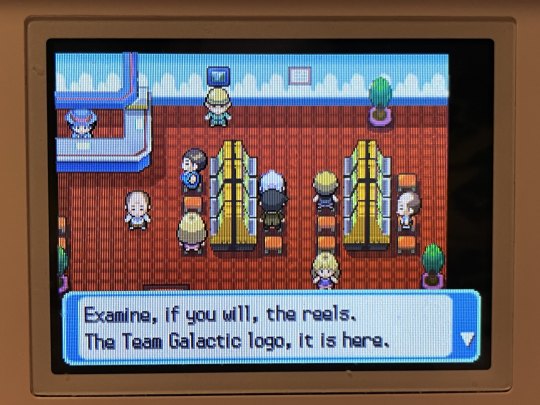
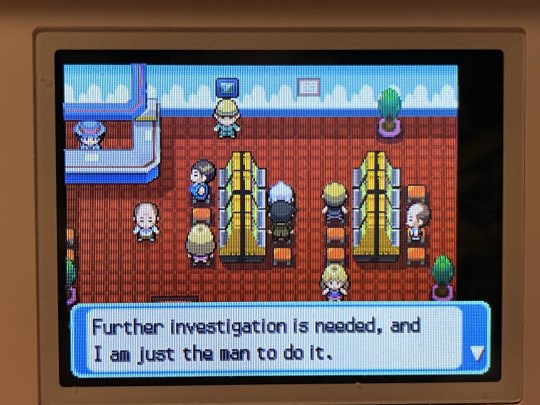
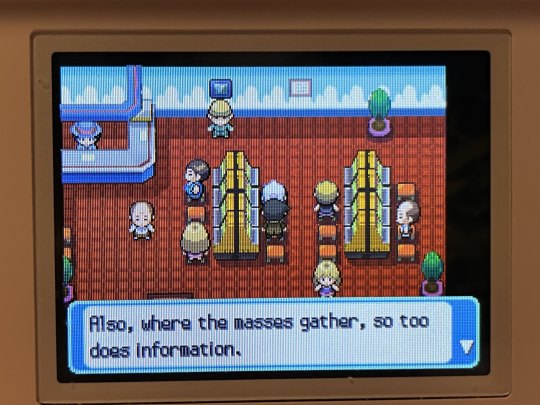
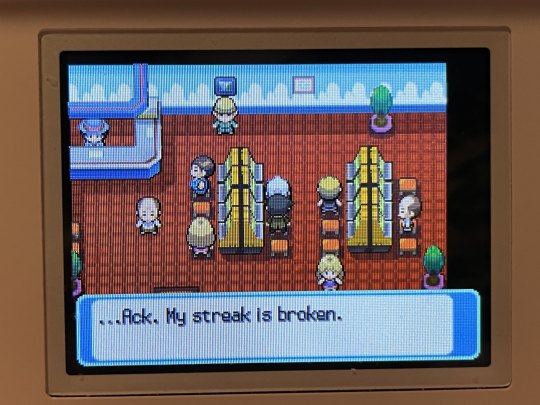
also LOOKER JUSTIFYING HIS GAMBLING :skull emoji: this shit is taking me out. see this is useful because it's like oh galactic is really all over this city huh. not only their massive building but they have their logo in the fucking slot machines, they probably have some amount of ownership over this place like team rocket did over the celadon game corner. but also it's funny because SDFSDFK
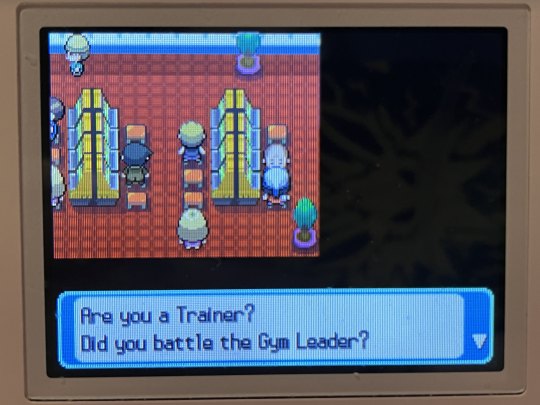
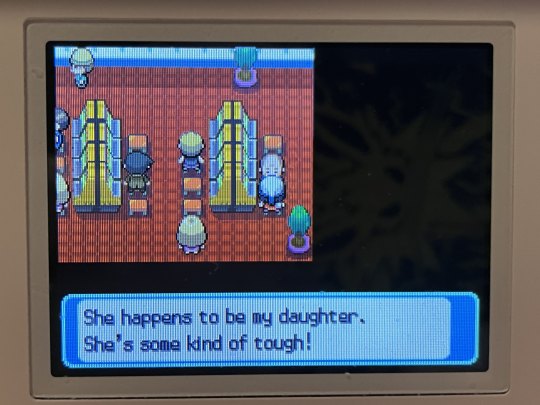
OH AND MAYLENE'S DAD IS JUST... HERE? generic NPC. generic sprite. no name. he's just here. maylene's dad. you know, one of the gym leaders. help girl
anyways i'm aware i basically just posted most of the dialogue in veilstone city verbatim but I JUST THINK IT'S INTERESTING! I MISS WHEN POKEMON GAMES WERE FULL OF DIALOGUE LIKE THIS AHHHH i have more to say about the galactic lore but i'm running out of image space and i need to use the bathroom and get some food so i'll post about that a little later
106 notes
·
View notes
Note
most under appreciated region in asoiaf? not by george but by us fans
STORMLANDS WARRIORS RISE RAHHHHHH
Like it’s got everything. Wales being the geographical inspiration is enough to get me on board look at the material and tell me this isn’t a place where old grudges never die and emotion rumbles through the air as easily as the storms




And the lore is some really good work by George I love when cultural mythos reflects the people’s history and that’s exactly what Durran is: a reflection of the people’s own struggle and triumph over the harshness of the land
And the people themselves and their attitudes are so good as well I love when people feel the need to yell everything out i love when someone loves their family and wants them dead with similar intensity I love when someone’s affection leaves bite marks and blood leftover. Maybe I’m projecting but I just love love love the idea of aggression as affection. The Stormlanders are just so emotionally rich I want to pick their brains
#asoiaf#stormlands my underrated beloveds#imagine if every plot point that’s currently going on in the riverlands happened in the stormlands instead…#five dead twelve injured Jamie lost his other hand while Brienne takes a bad road trip through her heritage
67 notes
·
View notes